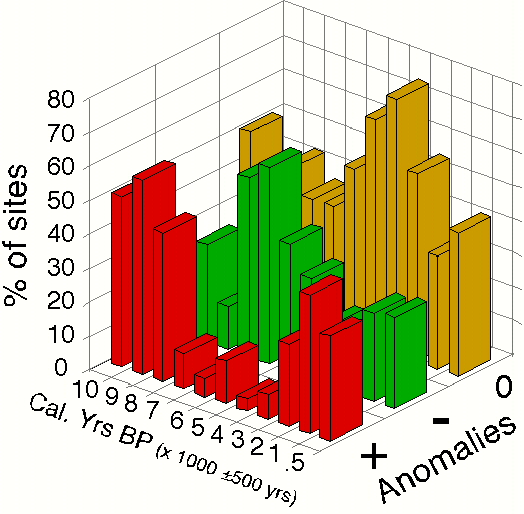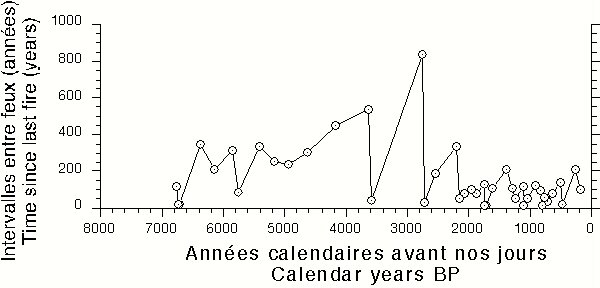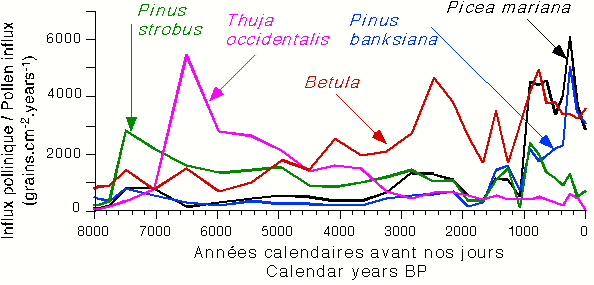Fire, climate and vegetation: A 9,000 years history
Because fire is
the most important disturbance in the boreal forest, it was crucial to try to describe its
history and its relation with climate and plant dynamic. Within the surroundings of the
Lake Duparquet Forest (FERLD), charcoal and pollen contents of well-stratified sediments
from a small kettle, Lake Francis, were analysed to detail this history over 7,000 years
before present (BP). In addition, analysis of a lacustrine charcoal data-base provided a
means of establishing the main features of the regional fire history and geography. This
double approach allows us to study first the climate-fire relationships and then
fire-vegetation relationship.
Climate-fire relationships
The
reconstruction of the fire history and geography was processed using a temporal
low-resolution spatial analysis of lacustrine charcoal accumulation rate. This
details fire occurrence for the last 10,000 years in Quebec (Fig. 1). The temporal
synthesis of the charcoal anomalies enhances the highlight of Quebec’s
fire history. A period characterised by positive anomalies (+) corresponds
to an environment conducive to fire, and vice versa for negative anomalies
(-). This synthesis does not take into account the regional singularity due
to vegetation, topography or micro-climate. Between 10,000-8,000 BP and
since 2,000 BP, Quebec experienced a climate conducive to
fire. Temperature did not appear to play a role because the hypsithermal
(8,000-5,000 BP) period was not only characterised by + anomalies. The fire
history and the lake-status history both depend on the precipitation regime.
But the historical discrepancies between fire and lake-status suggest that winter
snow accumulations trigger the lake-level fluctuations while late-spring or summer
droughts are the principal climatic force acting on fire occurrence. Thus high
fire occurrences are not inconsistent with high apparent precipitation records
since over the last 2000 years when Quebec has experienced an increase in occurrence
of drought events despite high annual precipitation.

Fig. 1 : Temporal synthesis of the anomalies of charcoal accumulation
rate during the last 10,000 years within Quebec.
|
Fire-vegetation relationships
Fire frequency
reconstruction at Lake Francis (Fig. 2) indicates that fires were not frequent between
6,800-2,200 BP. Indeed, mean fire interval was about 260 ±208 years before a
dramatic decrease to 85 ±55 years at about 2,200 BP. Because this change corresponds
and permits confirmation of the change recorded by temporal low-resolution analysis in
Quebec (Fig. 1), it provides evidence of the robustness of the fire reconstruction at Lake
Francis. This permits comparison of local fire-frequency reconstruction with the pollen
curves from the main tree species present over the last 7,000 years (Fig. 3).
Reconstruction of the fire-vegetation and fire-climate relationships thus provides a basis
for discussing the ecological consequences of climate changes. Between
9,500-7,500 BP, and after 2,200 BP, fire frequency was relatively high resulting
from a higher drought frequency. However, the latter period change was not synchronous
with changes in vegetation (Fig. 3). Indeed, during the period of low-fire frequency
between 6,800-2,200 BP, the vegetation surrounding Lake Francis was dominated by
white pine (Pinus strobus) and the Eastern white cedar (Thuja occidentalis),
while all other boreal tree species were already present. When fire interval decreased,
birch (Betula) pollen accumulation rate increased, and a few centuries later (ca.
1,500-1,000 BP) the current boreal forest dominated by balsam fir (Abies balsamea)
occupied the region. There appears to be a lag of a few centuries in vegetation changes in
relation to changes in fire frequency.

Fig. 2 : Frequency of fire events chronology at Lake Francis.
|

Fig. 3 : Pollen curves of major tree-taxa describing long-term plant
dynamics over the last 7,000 years.
|

|